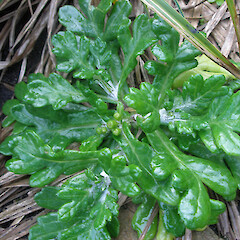Senecio radiolatus subsp. radiolatus
Synonyms
Senecio radiolatus F.Muell. subsp. radiolatus, Senecio lautus var. radiolatus (F.Muell.) Kirk
Family
Asteraceae
Flora category
Vascular – Native
Endemic taxon
Yes
Endemic genus
No
Endemic family
No
Structural class
Herbs - Dicotyledonous composites
NVS code
The National Vegetation Survey (NVS) Databank is a physical archive and electronic databank containing records of over 94,000 vegetation survey plots - including data from over 19,000 permanent plots. NVS maintains a standard set of species code abbreviations that correspond to standard scientific plant names from the Ngä Tipu o Aotearoa - New Zealand Plants database.
SENRSR
Chromosome number
2n = 40
Current conservation status
The conservation status of all known New Zealand vascular plant taxa at the rank of species and below were reassessed in 2017 using the New Zealand Threat Classification System (NZTCS) – more information about this can be found on the NZTCS website. This report includes a statistical summary and brief notes on changes since 2012 and replaces all previous NZTCS lists for vascular plants.
Please note, threat classifications are often suggested by authors when publications fall between NZTCS assessment periods – an interim threat classification status has not been assessed by the NZTCS panel.
- Conservation status of New Zealand indigenous vascular plants, 2017 . 2018. Peter J. de Lange, Jeremy R. Rolfe, John W. Barkla, Shannel P. Courtney, Paul D. Champion, Leon R. Perrie, Sarah M. Beadel, Kerry A. Ford, Ilse Breitwieser, Ines Schönberger, Rowan Hindmarsh-Walls, Peter B. Heenan and Kate Ladley. Department of Conservation. Source: NZTCS and licensed by DOC for reuse under the Creative Commons Attribution 4.0 International licence.
2017 | At Risk – Relict | Qualifiers: IE, Sp
Previous conservation statuses
2012 | At Risk – Naturally Uncommon | Qualifiers: IE, Sp
2009 | At Risk – Relict | Qualifiers: IE, RR, Sp
2004 | Range Restricted
Distribution
Endemic. Chatham Island group only
Habitat
Found on dunes and other coastal sites, such as in crevices where there is little soil, or on bouldery beaches. It is typically associated with the nesting sites of sea birds, and has been found on the lagoon-shore limestone cliffs.
Detailed description
Annual to short-lived, stout, grey-green to dark green, fleshy, erect perennial herb. Leaves mostly lanate when young, maturing glabrate or glabrous above, but remaining lanate beneath, base amplexicaul, cuneate; lamina 30-250 x 20-120 mm, dark grey-green, silvery-grey or dark green above, paler beneath, ovate to suborbicular, pinnately lobed to pinnatisect with many narrow to broad entire or few-toothed segments. Uppermost leaves smaller, less divided, narrow-obovate, broadly tapering to base. Supplementary bracts and calycular bracteoles variable, 3-16, 1.5-8 mm long. Involucral bracts 13-20, 4-9 mm long, glabrate. Ray florets 10-20, ligules dark yellow, 1.5-8 mm long. Disc yellow, 5-15 mm diameter. Cypsela 2.2-3.5 mm long, dark brown to black-brown, narrowly elliptic to narrowly oblong-elliptic, narrowed to and often slightly constricted below apex, base cuneate; ribs broad, rounded with narrow u-shaped grooves, hairs medium-length, retrorse, more or less evenly distributed or occasionally restricted to grooves. Pappus caducous, 5-7 mm long.
Similar taxa
Senecio antipodus is somewhat similar but has less divided leaves, discoid capitula (i.e. lacking ray florets), and smaller (2.0-3.0 cf. 2.5-3.5 mm long), glabrescent seeds with minutely papillate hairs mostly confined to the grooves. Senecio sterquilinus has recently been recognised on the Chatham Islands, and is superficially similar to S. radiolatus. From S. radiolatus, S. sterquilinus differs by its smaller widely branching habit, glabrescent stems and leaves which lack lanate hairs. The seeds of S. sterquilinus are very similar to S. radiolatus but not S. antipodus. As Senecio antipodus has never been part of published phylogenetic study, and the relationships between the Latusoid Senecio is complex, and best resolved by phylogenetic studies (Liew et al. 2018), species rank is here preferred over subspecies for S. radiolatus and S. antipodus.
Flowering
October - May
Flower colours
Yellow
Fruiting
November - June
Propagation technique
Easy from fresh seed. Short-lived but very attractive and easily grown. Does best in a moist, very fertile (high N, P, K) soil in full sun. Trials in the early 1990s at Percy Reserve and Petone proved tha tit is very attractive plant ideal for an annual border
Threats
Threatened by loss of its coastal habitat, loss of seabird colonies and browsing by introduced animals (including insects and molluscs).
Etymology
senecio: From the Latin senex ‘old man’ (probably referring to the bearded seeds)
Where To Buy
Not commercially available
Attribution
Fact Sheet prepared for NZPCN by P.J. de Lange 11 November 2008. Description based on Webb et al. (1988) supplemented with information obtained from fresh specimens and herbarium material.
References and further reading
Liew, C-S.; Memory, A.E.; Ortiz-Barrientos, D.; de Lange, P.J.; Pelser, P. 2018: The delimitation and evolutionary history of the Australasian Lautusoid group of Senecio (Asteraceae: Senecioneae). Taxon 67(1): 130-148. https://doi.org/10.12705/671.8
Webb CJ, Sykes WR, Garnock-Jones PJ 1988. Flora of New Zealand. Vol. IV. Botany Division, DSIR, Christchurch.
NZPCN Fact Sheet citation
Please cite as: de Lange, P.J. (Year at time of access): Senecio radiolatus subsp. radiolatus Fact Sheet (content continuously updated). New Zealand Plant Conservation Network. https://www.nzpcn.org.nz/flora/species/senecio-radiolatus-subsp-radiolatus/ (Date website was queried)











